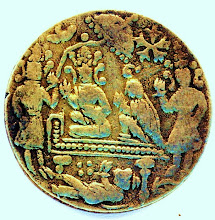
















King Edward VII Reign 22 January 1901 - 6 May 1910
Edward VII (Albert Edward; 9 November 1841 – 6 May 1910) was King of the United Kingdom of Great Britain and Ireland, King of the Commonwealth Realms, and Emperor of India from 22 January 1901 until his death on 6 May 1910.
Before his accession to the throne, Edward held the title of Prince of Wales, and has the distinction of having been heir apparent to the throne longer than anyone in English or British history.[1] During the long widowhood of his mother, Queen Victoria, he was largely excluded from wielding any political power but came to represent the personification of the fashionable, leisured elite.
Edward's reign, now called the Edwardian period after him, saw the first official recognition of the office of the Prime Minister in 1905. Edward played a role in the modernization of the British Home Fleet, the reform of the Army Medical Services,[2], and the reorganisation of the British army after the Second Boer War. His fostering of good relations between
He was the first British monarch of the House of Saxe-Coburg-Gotha, which was renamed by his son, George V, to the House of Windsor.
King Edward succeeded by his Son King George V.
The Coin above minted by East India Company during King Edward Rule.


Victoria (Alexandrina Victoria; 24 May 1819 – 22 January 1901) was the Queen of the United Kingdom of Great Britain and Ireland from 20 June 1837, and the First Empress of India from 1 May 1876, until her death on 22 January 1901. Her reign lasted sixty-three years and seven months, longer than that of any other British monarch. In general, the period centred on her reign is known as the Victorian era.
The Victorian era was at the height of the Industrial Revolution, a period of significant social, economic, and technological progress in the
Victoria's father died of pneumonia eight months after she was born and her grandfather, George III, died six days later. Her uncle, the Prince of Wales, inherited the Crown, becoming King George IV but he too died childless when
William too had no surviving legitimate children. (Although he was the father of ten illegitimate children by his mistress, the actress Dorothy Jordan). As a result, the young Princess Victoria became heiress presumptive.
Queen Victoria succeeded by her son Edward VII.



He served in the Royal Navy in his youth and was, both during his reign and afterwards, nicknamed the "Sailor King". He served in North America and the
At his death William had no surviving legitimate children, though he was survived by eight of the ten illegitimate children he had by the actress Dorothea Jordan, with whom he cohabited for 20 years. British Conservative Party leader David Cameron is one of their descendants. William was succeeded in the
Coins above are minted by East India Company during King William Rule, He had a trade ties with Mogul Rulers. The coins which are in English & Mogul pattern.


Economic and historical studies of money's use and development are an integral part of the numismatists' study of money's physical embodiment.Coin Collecting may have existed in ancient times. Caesar Augustus gave "coins of every device, including old pieces of the kings and foreign money" as Saturnalia gifts.
Petrarch, who wrote in a letter that he was often approached by vinediggers with old coins asking him to buy or to identify the ruler, is credited as the first Renaissance collector. Petrarch presented a collection of Roman coins to Emperor Charles IV in 1355.
The first book on coins was De Asse et Partibus (1514) by Guillaume Budé.[3]. During the early Renaissance ancient coins were collected by European royalty and nobility. Collectors of coins were Pope Boniface VIII, Emperor Maximilian of the Holy Roman Empire, Louis XIV of France, Ferdinand I, Elector Joachim II of Brandenburg who started the Berlin coin cabinet and Henry IV of France to name a few. Numismatics is called the "Hobby of Kings", due to its most esteemed founders.
Professional societies organized in the 19th century. The Royal Numismatic Society was founded in 1836 and immediately began publishing the journal that became the Numismatic Chronicle.
The American Numismatic Society was founded in 1858 and began publishing the American Journal of Numismatics in 1866.
In 1931 the British Academy launched the Sylloge Nummorum Graecorum publishing collections of Ancient Greek coinage. The first volume of Sylloge of Coins of the British Isles was published in 1958.
In the 20th century as well the coins were seen more as archaeological objects. After World War II in Germany a project, Fundmünzen der Antike (Coin finds of the Classical Period) was launched, to register every coin found within Germany. This idea found successors in many countries.
In the United States, the US mint established a coin Cabinet in 1838 when chief coiner Adam Eckfeldt donated his personal collection.[4] William E. Du Bois’ Pledges of History... (1846) describes the cabinet.
C. Wyllys Betts' American colonial history illustrated by contemporary medals (1894) set the groundwork for the study of American historical medals.
Modern numismatics
Modern numismatics is the study of the coins of the mid 17th to the 21st century, the period of machine struck coins. Their study serves more the need of collectors than historians and it is more often successfully pursued by amateur aficionados than by professional scholars. The focus of modern numismatics lies frequently in the research of production and use of money in historical contexts using mint or other records in order to determine the relative rarity of the coins they study. Varieties, mint-made errors, the results of progressive die wear, mintage figures and even the socio-political context of coin mintings are also matters of interest.





